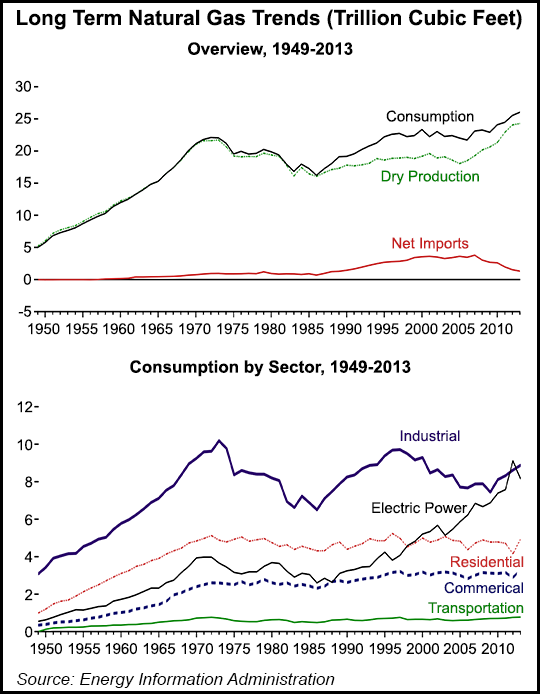NGI Archives | NGI All News Access | NGI The Weekly Gas Market Report
U.S. Natural Gas Production Continued Long-Running Ramp-Up in February, EIA Says
U.S. natural gas production was 2.38 Tcf in February, up from 2.31 Tcf in February 2013, continuing a ramp-up that resulted in a record 30.17 Tcf production total in 2013, according to the Energy Information Administration’s (EIA) latest Monthly Energy Review(MER).

February marked the 12th consecutive month that production has been higher than it was a year previously, according to the MER.
U.S. natural gas production, which had remained relatively stagnant for several years (between 23.46 Tcf and 24.66 Tcf from 2000-2007), began a steep acceleration coinciding with the blooming of the nation’s shale plays, reaching 25.64 Tcf in 2008, 26.06 Tcf in 2009, 26.82 Tcf in 2010, 28.48 Tcf in 2011 and 29.54 Tcf in 2012, data indicated.
Total marketed production (wet) in February was 2.00 Tcf, compared with 1.94 Tcf in February 2013. Dry gas production was 1.90 Tcf, compared with 1.84 Tcf in February 2013.
EIA reported 133 Bcf of natural gas exports in February, unchanged compared with February 2013, and imports were 247 Bcf, increased from 237 Bcf in the year-ago period.
The U.S. Department of Energy (DOE) recently gave its sixth conditional approval to export liquefied natural gas (LNG), this time to Sempra Energy’s Cameron LNG LLC in Cameron Parish, LA (see Daily GPI, Feb. 11). With DOE’s Cameron approval the volume of authorized and conditionally authorized exports to non-free trade agreement countries climbed to 8.47 Bcf/d.
Domestic consumption of natural gas was on the rise in February, reaching 2.82 Tcf, compared with 2.62 Tcf in February 2013, EIA said. Consumption in the electric power sector decreased to 554 Bcf, compared with 565 in the year-ago period, but was up in all other sectors: residential consumption was 859 Bcf (compared with 756 Bcf in February 2013); commercial was 489 Bcf (428 Bcf); industrial was 773 Bcf (733 Bcf); and transportation was 81 Bcf (75 Bcf).
Natural gas accounted for 79% of primary energy consumption by the residential and commercial sectors combined, EIA said.
Winter weather accounted for more than 5 Bcf/d of increased domestic gas demand this past winter, according to Raymond James & Associates Inc. (see Daily GPI, May 27).
© 2024 Natural Gas Intelligence. All rights reserved.
ISSN © 1532-1231 | ISSN © 2577-9877 | ISSN © 1532-1266 |
